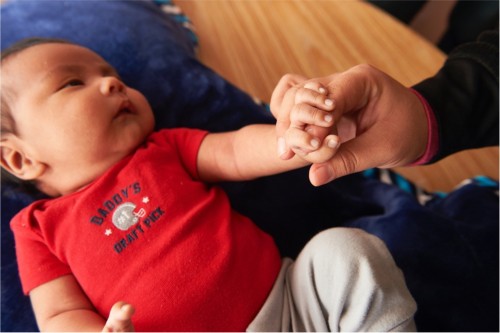
In partnership with the Navajo Nation and Alaska Native Tribal Health Consortium, we are conducting a study to assess whether Vaxelis, a hexavalent combination vaccine, provides a similar protective antibody response against H. influenzae type b (Hib) after the first dose as PedvaxHIB (Hib PRP-OMP), the currently recommended vaccine against Hib in American Indian and Alaska Native (AI/AN) children.
Background on Haemophilus influenzae b (Hib) and Vaxelis
Historically, American Indian and Alaska Native (AI/AN) children aged <5 years have experienced invasive H. influenzae type b (Hib) disease at a rate that is at least 5 times higher than the general U.S. population. In the pre-vaccine era, the incidence of Hib disease peaked earlier for AI/AN children at 4-5 months than general US children at 6-9 months. Studies performed in AI/AN children revealed that Hib PRP-OMP induced a protective antibody response against Hib with the first dose, which is given at 2 months. Following introduction of a two-dose primary series and a booster dose, the rate of Hib disease decreased substantially among AI/AN children
Vaxelis is a licensed hexavalent combination vaccine that contains Hib PRP-OMP and five other antigens (Hepatitis B surface antigen, Diphtheria Toxoid, Tetanus Toxoid, Acellular Pertussis [DTaP], and Inactivated Polio Virus [IPV]). Vaxelis received FDA approval in 2018 and is now recommended by the CDC for use in US infants as part of the routine immunization schedule. The CDC did not provide a preferential recommendation for AI/AN infants because the protection after one dose is not yet known.
About the HibVax Study
The main goal of the study is to compare the immune response in AI/AN infants to these two licensed and recommended Hib vaccines Vaxelis and PedvaxHIB. The study aims to enroll approximately 330 AI/AN infants on Navajo Nation, White Mountain Apache Tribal lands, and in Alaska starting in fall 2021.
Following parental informed consent, babies in the study will receive either Vaxelis or PedvaxHIB along with the other routinely recommended childhood vaccines at 2, 4, and 6 months of age. Blood samples will be collected four times to measure antibody levels against Hib. Participants will be followed for approximately 5 months. Being in the study will not affect the clinical care the participant receives. All information about participants will be kept confidential.
If this study finds that Vaxelis and PedvaxHIB provide comparable protection after one dose, this would support the CDC making a preferential recommendation for Vaxelis for AI/AN infants. This would expand the options of preferred vaccines for AI/AN infants and potentially provide more long-lasting protection.
Navajo Nation IRB number: #NNR-20.374T
Alaska Area IRB number: 2020-02-011-4
Learn more about the study on clinicaltrials.gov: https://clinicaltrials.gov/ct2/show/NCT04978818?cond=Immunogenicity+of+H.+influenzae+type+b+PRP-OMP+vaccine+in+American+Indian+and+Alaska+Native+children&draw=2&rank=1